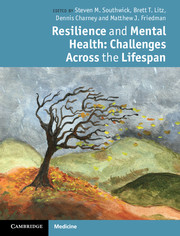Book contents
- Frontmatter
- Contents
- Contributors
- Preface
- Section 1 Pathways to resilience
- Section 2 Resilience across the lifespan
- 7 Resilience in children and adolescents
- 8 Toward a lifespan approach to resilience and potential trauma
- 9 Resilience in older adults
- Section 3 Resilience in families, communities, and societies
- Section 4 Specific challenges
- Section 5 Training for resilience
- Index
- References
7 - Resilience in children and adolescents
from Section 2 - Resilience across the lifespan
Published online by Cambridge University Press: 07 September 2011
- Frontmatter
- Contents
- Contributors
- Preface
- Section 1 Pathways to resilience
- Section 2 Resilience across the lifespan
- 7 Resilience in children and adolescents
- 8 Toward a lifespan approach to resilience and potential trauma
- 9 Resilience in older adults
- Section 3 Resilience in families, communities, and societies
- Section 4 Specific challenges
- Section 5 Training for resilience
- Index
- References
Summary
Introduction
In the sciences concerned with human development, resilience can be defined as the capacity of a dynamic, living system to endure or recover from a major disturbance and continue to develop in healthy ways. Resilience is a broad systems concept that generally refers to the capacity of any dynamic system to adapt or recover from a significant threat to its function or viability. It can be applied to an individual, a family, an organization, or an ecosystem. Interest in resilience emerged independently in the ecological and social sciences around the same time (late 1960s and early 1970s), probably as a result of common roots in general systems theory (Masten & Obradović, 2008).
Judging from ancient tales of young heroes and heroines, people have been intrigued with the idea of overcoming adversity for millennia. The science of resilience in children, however, emerged in the 1960s as investigators, searching for the causes of mental illnesses such as schizophrenia and behavioral problems such as delinquency, began to study children at risk for psychopathology (Luthar, 2006; Masten, 2007, 2011). The rationale behind this approach was to begin research before disorders were evident in order to study their causes and course of development (Garmezy & Streitman, 1974; Watt et al., 1984; Obradović et al., 2011). When investigators began to study groups of children believed to be at risk, the striking variability in the life course among the individual children became apparent. The diversity in outcomes of children who shared risk factors was impressive, particularly when followed forward in time. Investigators were confronted with the puzzle of numerous young people in “high-risk” groups who were showing positive mental health and development.
- Type
- Chapter
- Information
- Resilience and Mental HealthChallenges Across the Lifespan, pp. 103 - 119Publisher: Cambridge University PressPrint publication year: 2011
References
- 23
- Cited by

